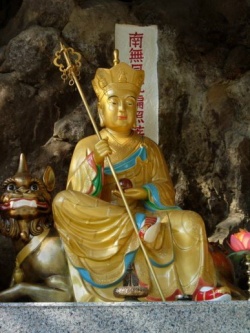Lung – Breath
Lung (Tibetan: rlung) is a word that means ‘wind’ or ‘breath’. It is a key concept in the Vajrayana traditions of Tibetan Buddhism and as such is part of the symbolic ‘twilight language’, used to non-conceptually point to a variety of meanings.
Lung is a concept that is particularly important to understandings of the subtle body and the Three Vajra's (body, speech and mind). Tibetan medicine practitioner Dr. Tamdin Sither Bradley provides a summary:
The general description of rLung is that it is a subtle flow of energy and out of the five elements (air, fire, water, earth and space) it is most closely connected with air. However it is not simply the air which we breathe or the wind in our stomachs, it goes much deeper than that. rLung is like a horse and the mind is the rider, if there is something wrong with the horse the rider will not be able to ride properly. Its description is that it is rough, light, cool, thin, hard, movable. The general function of rLung is to help growth, movement of the body, exhalation and inhalation and to aid the function of mind, speech and body. rLung helps to separate in our stomachs what we eat into nutrients and waste products. However its most important function is to carry the movements of mind, speech and body. The nature of rLung is both hot and cold. [Bradley, Tamdin Sither (2000). "Tibetan Medicine - How and Why it Works"]
Usuages
Some of the different usages of the term “lung” include:
- the psychic winds (sanskrit: “prana”) that travel in the internal channels, or “nadi” (sanskrit) of the subtle body and are manipulated in certain Vajrayana yoga practices.
- specifically the five psychic winds that are a manifestation of the Mahabhuta. These five are the life-force that animate the body-mind (Sanskrit: “namarupa”) of all sentient beings and are key to certain tantric Buddhist and Bön sadhana's and Traditional Tibetan medicine.
- as a component of the term for a type of prayer flag, named after the allegorical Wind Horse (Tibet: “lung ta”).
- a type of tantric Buddhist empowerment that involves the transference of spiritual power from master to augment or refine that of the disciple through the recitation of scripture or song. This oracular transmission received aurally defines Mantrayana and Ngagpa traditions and provides them with their nomenclature.
Tibetan Medicine
Tibetan medicine, a discipline practiced throughout the Himalayan region, identifies a system of ‘The Five Lung’ which help to regulate the human body:
- ’Life-grasping lung’ (Tibetan:”Srog ‘dzin rlung”‘ alt.: “Strog Zin”) is located in the brain. This lung regulates swallowing, inhalation, spitting, eructation, sneezing, and generally clearing the senses and steadying of the mind and concentration.
- ’Upward moving lung’ (Tibetan:”Gyen-rgyu rlung”) is located in the chest and thorax. This lung regulates speech, energy to work, body weight, memory, the increase of bodily vigor and health, complexion and the skin luster, mental endeavor and diligence.
- ’All pervading lung’ (Tibetan:”Khyab-byed rlung”) is located is in the heart. This lung regulates lifting, walking, stretching and the contraction of muscles: opening and closing of the mouth, eyelids, anus etc.
- ’Fire accompanying lung’ (Tibetan:”Me-mnyam rlung”‘) is located is in the stomach and abdomen area. This lung regulates digestion and the metabolism. This lung also ripens the Seven Bodily Sustainers (Tibetan: “lus-zung dhun”).
- ’Downward cleansing lung’ (Tibetan:”Thur-sel rlung”) is located in the rectum, bowels and perineal region and its function is to expel farces, urine, semen, menstruation, uterine contractions and the fetus.
Tibetan Buddhism views the human body as consisting of a coarse body made of six constituent elements of earth, water, fire, wind, space and consciousness and also of a subtle body, or ‘Vajra body’, of energy-winds, energy-channels and energy-drops. There are many types of wind or ‘subtle breath’ that move along the invisible channels of the subtle body. The ‘vital breath’ (Tibetan:”sog lung” ) is considered the most important. It is “the essence of life itself that animates and sustains all living beings”. [Judith Simmer-Brown, Dakini's Warm Breath:The Feminine Principle in Tibetan Buddhism, 2002, p.169]
Anuttarayoga Tantra practices from the Mahamudra meditation system, such as Guhyasamaja, Chakrasamvara and Hevajra, provide various methods to penetrate the vital points of the Subtle Body. Dalai Lama XIV summarizes the practice: “To penetrate these points means to gather there the energy-winds and the subtle minds that ride on them, basically by means of different types of absorbed concentration focused on these spots.” [Tenzin Gyatso and Alexander Berzin, The Gelug/Kagyu Tradition of Mahamudra, 1997, p.219] .
Practices that work with the subtle energy winds includes tummo or ‘Inner Fire’, one of the Six Yogas of Naropa. In this practice, the yogin or yogini uses breathing and meditation techniques to draw the lung or subtle winds into the central channel and hold them there, traversing the body vertically.
Tsa Lung
Tsa Lung (Skt: “nadi-vayu”; Tib. “rtsa rlung”; where “rtsa” denotes an energetic channel) are special yogic exercises. [Tenzin Wangyal, 2002, p.89 "Healing with Form, Energy, and Light"] The exercises are used in the Tibetan Bön tradition and the Nyingma and Drikung Kagyu schools of Tibetan Buddhism. Tsa lung Trul khor employs the “tsa lung” and they constitute the internal yantra or sacred architecture of this yoga’s alternate nomenclature, Yantra Yoga. “Tsa lung” are also employed in Kye-rim.
The exercises are used:
- to open major chakra's and
- to bring the “lung” from the side channels into the central channel. [Tenzin Wangyal, 2002, p.82 "Healing with Form, Energy, and Light"]
That coincides with mind releasing dualistic misperceptions and abiding in non-dual awareness of rigpa (Tib. “rig pa”). Detailed instructions on the exercises describe 3 levels of “rtsa rlung”: external, internal and secret.
Each level contains 5 exercises corresponding to five elements. [Tenzin Wangyal, 2002, p.76-110 "Healing with Form, Energy, and Light"]




